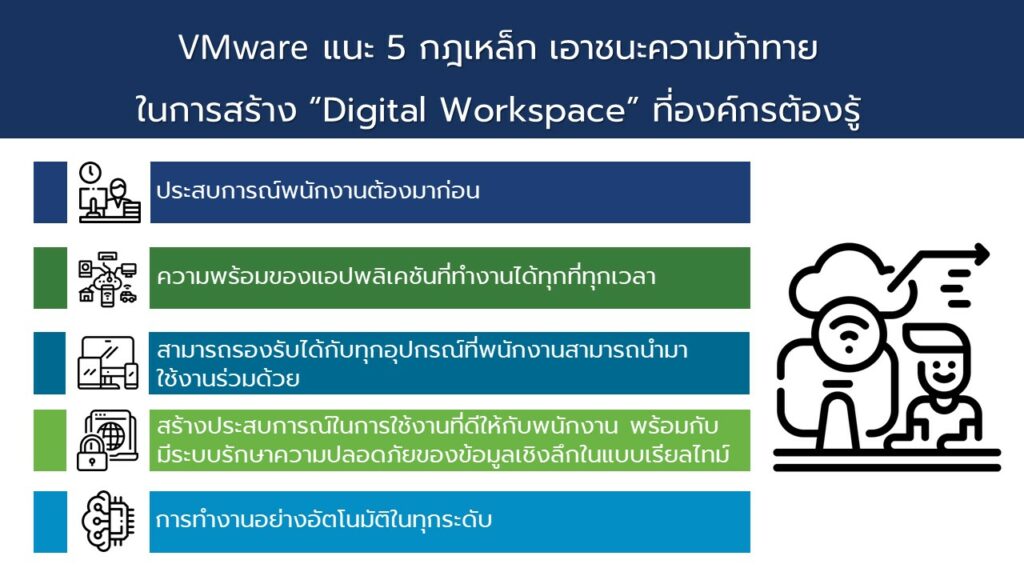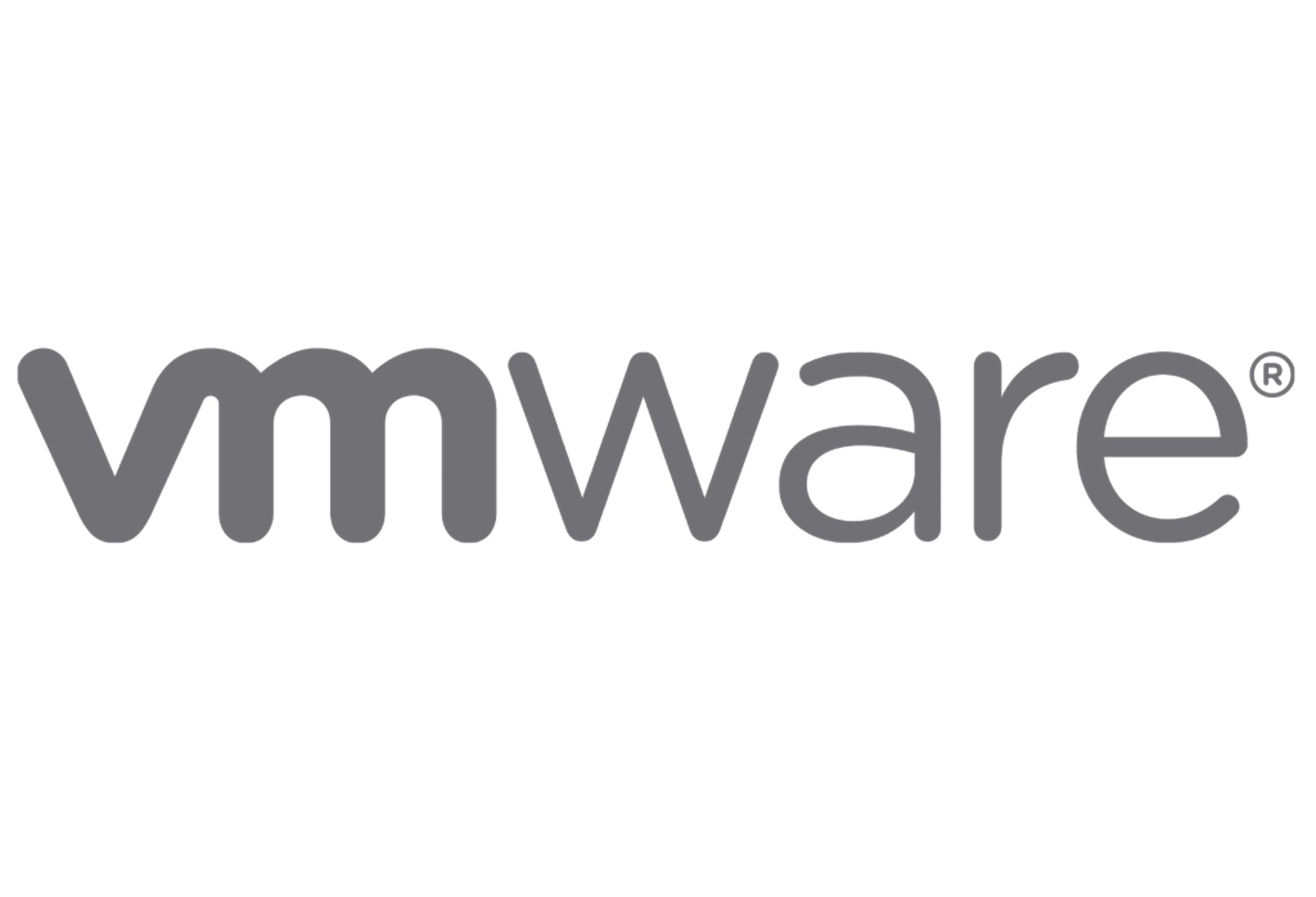Attributed to: Ekpawin Sukanan, Country Manager, VMware Thailand
Remote working is not a new idea and has been in practice for a number of years. However, the COVID-19 pandemic has pushed business continuity and remote working to the top of every business’ agenda due to various forms of movement restriction implemented around the world. The need for a seamless, secure digital workspace has now become a necessity in order for the world’s remote workforce to work from anywhere, any time and on any device.
At this critical juncture, organizations need to make the employee digital experience a priority as it has a direct impact on their bottom line. A Forbes study found that when companies provide employees seamless access to critical applications anytime and anywhere, they reported 17% savings in time, ultimately freeing up their time to focus on more important tasks, improving personal productivity and organizational efficiency.
Despite all the conversations around the digital workspace, IT leaders still find it challenging to plan for the changes required to make a seamless, secure digital workspace a reality. Many of the skills, tools, and processes used today are based on 20-year-old, PC-based technology. A new approach is needed to ensure a successful digital workplace strategy – and here are 5 critical requirements for employers and IT leaders to take note of.
1. Putting Employee Experience First
Putting employee experience as the first requirement for a digital workspace is not a simple nod to keeping employees in mind as you go about the business of delivering IT. Instead, building a strong design culture around the employee experience is critical to meet the demands of the business, as well as the ability to secure sensitive corporate data at a time when the workforce is largely remote.
IT must put themselves in a position to design and deliver the productivity experiences employees will use. This takes into account the devices and form factors employees use throughout the day, the locations from which they need to work, as well as providing a level of flexibility and choice that will keep up with the demands of employees and departments. In many cases, this takes a shift in skills and culture, but it also represents growth opportunities across IT.
2. Delivery of Applications – Anytime, Anywhere
The next critical requirement is the ability to deliver any application through the digital workspace experience. Supporting all apps – mobile, cloud-based, web-based, task-based, Windows legacy, etc. – is a must. Not only is it necessary to support all apps, but they also need to be supported from any device, anywhere your employees are located. Businesses can’t deliver an employee experience if they aren’t able to deliver the applications they need.
Making applications highly accessible is crucial in boosting employee performance and productivity, two extremely important factors that determine business success and profitability. In a Forbes study of 2,000 executives and frontline employees worldwide, the executive CIOs who have already made applications readily accessible to employees estimated an 18% increase in revenue due to these applications.
By definition, a digital workspace that doesn’t include all of the applications an employee needs to do their job when and wherever they need them, is not a true digital workspace. The platform must be equipped to deal with the hundreds of Windows applications you may already have with the new and existing web, SaaS, and native mobile applications.
3. Modern Device Management
PC Lifecycle Management is now the way of the past. Modern device management allows IT to manage with a cloud-based, on-demand approach, anywhere and on any device to deliver drastic time and cost savings to organizations. Not only does this provide organizations with immense scalability, but IT can also manage devices with zero-touch provisioning, seamless software distribution, and intrinsic security. There is no question that, in the near future, every enterprise-managed or personal device accessing corporate data will be connected to a modern device management platform.
The question is, when? Many organizations have heavily invested in years of tools, skills, and processes revolving around domain-based management of PCs and Macs. We believe modern device management is the only way to deliver consistent experiences in a border-less work environment by having real-time context of the devices used to access the apps and data employees need to do their best work. Device management helps secure access management so there is only one app and one place to go. It also ensures unified endpoint management for a consistently great user experience that is also highly secure.
4. Managing Employee Experience and Security with Real-time Data and Insights
With the digital workspace in place, IT is in an ideal position to proactively drive successful experiences through measuring and tracking adoption and usage of applications across devices. Instead of reacting to historical data, IT now has the ability to access real-time insights from data which provide the ability to spot trends, identify gaps in experience and security, and make recommendations for change. IT needs to ensure that their device management platforms provide them with complete visibility into their digital workspace in order to gain the deep insights required that in turn enable data-driven decisions across the entire digital environment.
5. Automate to Succeed at Any Scale
In the end, having visibility and even control of this new digital workspace environment is fantastic, but with more devices, more apps, and more threats, the digital workspace becomes increasingly complex. To handle the massive scale and complexity of a digital workspace, automation is critical for onboarding, deploying apps, serving up patches and updates, as well as automating remediation steps for policy compliance based on intelligence. IT needs to be proactive in security instead of reacting to malicious threats after the fact. A proactive approach helps to eliminate the need for users to generate tickets requiring IT administrators to take manual action. Ultimately, automation keeps operational costs low and removes inconsistencies across devices.
The Digital Workspace is here to stay
As we find ourselves in this new paradigm where a remote workforce is the norm, organizations must harness technology to ensure business continuity. This means building a digital foundation that enables the architecting and delivery of digital products and services to employees and customers alike.
Implementing and maintaining an employee-focused digital workspace is critical towards achieving business success. IT leaders need to lead the charge toward a more efficient, user-friendly, seamless and secure digital environment. Taking the right steps now — examining and incorporating the five requirements discussed here — will help to ensure the likelihood that employees will adopt new apps and adhere to new IT policies that are put in place now and in the future, thereby securing success for the organization in the increasingly competitive, digitalized business environment.
โดย นายเอกภาวิน สุขอนันต์ ผู้จัดการประจำวีเอ็มแวร์ ประเทศไทย
การทำงานแบบรีโมทไม่ใช่เรื่องใหม่ และเกิดขึ้นมาหลายปีแล้ว แต่สถานการณ์การแพร่ระบาดของโควิด-19 ทำให้การทำงานแบบรีโมทกลายเป็นจุดเปลี่ยนสำคัญของความอยู่รอดขององค์กรต่างๆ เมื่อธุรกิจยังต้องดำเนินต่อไปภายใต้สถานการณ์ทั่วโลกที่เปลี่ยนแปลงไป เพื่อให้องค์กรสามารถดำเนินธุรกิจได้อย่างต่อเนื่องโดยไม่สะดุด จำเป็นต้องอาศัยดิจิทัลเวิร์คสเปซที่ปลอดภัย รองรับการทำงานได้ทุกที่ทุกเวลา และบนทุกอุปกรณ์
ในช่วงเวลาหัวเลี้ยวหัวต่อที่สำคัญนี้ องค์กรต่าง ๆ จำเป็นต้องให้ความสำคัญต่อประสบการณ์การทำงานดิจิทัลของพนักงาน เนื่องจากมีผลกระทบโดยตรงต่อการทำกำไรของธุรกิจ ผลการศึกษาของ Forbes พบว่า เมื่อบริษัทให้พนักงานเข้าถึงแอปพลิเคชันที่จำเป็นขององค์กรได้ทุกที่ ทุกเวลา สามารถประหยัดเวลาทำงานได้ถึง 17% ซึ่งทำให้พวกเขามีเวลาสำหรับพัฒนาทักษะที่จำเป็นต่อการทำงานและเพิ่มประสิทธิภาพขององค์กรมากขึ้น

แม้ว่าดิจิทัลเวิร์คสเปซจะถูกหยิบยกมาพูดกันอย่างกว้างขวาง แต่หัวหน้าฝ่ายไอทียังคงพบว่า มันเป็นเรื่องท้าทายในการวางแผนเพื่อเปลี่ยนแปลงไปสู่การปฏิบัติงานแบบ ดิจิทัลเวิร์คสเปซ ที่แท้จริงอย่างราบรื่นและปลอดภัย อีกทั้งทักษะ เครื่องมือ และกระบวนการต่าง ๆ ที่ใช้กันอยู่ในปัจจุบันนี้ ล้วนมีรากฐานมาจากเทคโนโลยีระดับพีซีสมัย 20 ปีก่อน จึงจำเป็นต้องมีวิธีการใหม่ๆ เพื่อให้มั่นใจว่ากลยุทธ์การทำงานแบบดิจิทัลเวิร์คสเปซจะประสบความสำเร็จ และนี่คือกฎเหล็ก 5 ประการสำหรับองค์กรและฝ่ายไอทีที่ต้องตระหนักหากต้องการสร้างดิจิทัลเวิร์คสเปซให้ประสบความสำเร็จ
- ประสบการณ์พนักงานต้องมาก่อน
การนำประสบการณ์พนักงานมาใช้เป็นข้อกำหนดแรกสำหรับการสร้างดิจิทัลเวิร์สเปซนั้นไม่ใช่เรื่องง่าย แม้ว่าคุณจะดำเนินธุรกิจเกี่ยวข้องกับอุตสาหกรรมไอทีก็ตาม ในความเป็นจริงแล้วการสร้างวัฒนธรรมและประสบการณ์ดิจิทัลของพนักงานที่แข็งแกร่งนั้น มีความสำคัญต่อการตอบสนองความต้องการของธุรกิจเช่นเดียวกับความสามารถในการรักษาความปลอดภัยข้อมูลองค์กรในเวลาที่พนักงานส่วนใหญ่ทำงานนอกสถานที่ หรือทำงานจากที่บ้าน
ฝ่ายไอทีต้องทำหน้าที่ออกแบบเวิร์คสเปซเพื่อส่งต่อประสบการณ์ทำงานที่เหมาะสมกับพนักงาน โดยต้องคำนึงถึงความสามารถในการรองรับอุปกรณ์ทุกรูปแบบ และลักษณะการปฏิบัติงานของพนักงานตลอดทั้งวัน รวมถึงสถานที่ทำงาน เช่นเดียวกับระดับความยืดหยุ่นและทางเลือกที่สอดคล้องกับความต้องการของพนักงานและแต่ละแผนก ในหลายกรณีสิ่งเหล่านี้จะช่วยเสริมทักษะและวัฒนธรรมขององค์กร แต่ก็ยังหมายถึงโอกาสในการเติบโตของฝ่ายไอทีอีกด้วย
- ความพร้อมของแอปพลิเคชันที่ทำงานได้ทุกที่ทุกเวลา
กฎสำคัญข้อต่อไปคือ ความสามารถในการให้พนักงานใช้แอปพลิเคชันที่จำเป็นทั้งหมดผ่านประสบการณ์ดิจิทัลเวิร์คสเปซ ไม่ว่าจะเป็นอุปกรณ์พกพา, Cloud-based, Web-based, task-based, Windows legacy ฯลฯ ซึ่งเป็นสิ่งที่ขาดไม่ได้ และต้องรองรับแอปได้ทั้งหมด ไม่ว่าพนักงานของคุณจะอยู่ที่ใด องค์กรจะไม่สามารถสร้างประสบการณ์ดิจิทัลที่ดีของพนักงานได้ ถ้ายังไม่สามารถให้พนักงานเข้าถึงแอปพลิเคชันที่จำเป็นได้ทั้งหมด
นอกจากนี้การทำให้พนักงานสามารถเข้าถึงแอปพลิเคชันได้ง่ายเป็นอีกปัจจัยสำคัญที่ช่วยเพิ่มประสิทธิภาพ และผลงานของพนักงาน อันเป็นสองปัจจัยที่เป็นตัวกำหนดความสำเร็จและผลกำไรทางธุรกิจ ผลการศึกษาของ Forbes ที่สำรวจความคิดเห็นจากผู้บริหารและพนักงานระดับแนวหน้าทั่วโลกกว่า 2,000 คน ระบุว่า บริษัทที่ผู้บริหารระดับซีไอโอออกแบบแอปพลิเคชันให้พนักงานเข้าถึงได้ง่ายนั้น จะมีรายได้เพิ่มขึ้นถึง 18% จากการใช้แอปพลิเคชัน
กล่าวคือ หากต้องการสร้างดิจิทัลเวิร์คสเปซให้ประสบความสำเร็จ ก็ต้องรวมทุกความต้องการของพนักงาน และความสามารถในการเข้าถึงทุกแอปพลิเคชันจากทุกอุปกรณ์ ทุกที่ และทุกเวลา โดยแพลตฟอร์มดังกล่าวจะต้องติดตั้งเพื่อให้สามารถจัดการกับแอปพลิเคชันบน Windows หลายร้อยรายการที่คุณอาจมีอยู่ ร่วมกับเว็บใหม่และเว็บเดิมที่มีอยู่, SaaS และแอปพลิเคชันมือถือทั่วไป
- สามารถรองรับได้กับทุกอุปกรณ์ที่พนักงานสามารถนำมาใช้งานร่วมด้วย
การบริหารจัดการในระดับพีซีได้กลายเป็นอดีตไปแล้ว ปัจจุบันก้าวสู่ยุคการบริหารจัดการโมเดิร์นดีไวซ์ที่ช่วยให้ฝ่ายไอทีสามารถจัดการกับระบบคลาวด์ตามความต้องการได้ทุกที่และทุกอุปกรณ์ ช่วยให้องค์กรสามารถประหยัดเวลาและลดค่าใช้จ่ายลงได้ สิ่งนี้ไม่เพียงช่วยขยายขีดความสามารถขององค์กร แต่ยังช่วยให้ไอทีสามารถบริหารจัดการอุปกรณ์ที่มี ในแบบ zero-touch provisioning, ทำ software distribution อย่างลื่นไหล และอยู่บนระบบความปลอดภัยที่แท้จริง ไม่ต้องสงสัยเลยว่าในอนาคตอันใกล้นี้ อุปกรณ์ที่มีการจัดการหรือการเข้าถึงข้อมูลส่วนบุคคลขององค์กรจะต้องเชื่อมต่อกับแพลตฟอร์มการจัดการโมเดิร์นดีไวซ์
คำถามคือเมื่อไหร่? หลายองค์กรมีการลงทุนในด้านเครื่องมือ การพัฒนาทักษะ กระบวนการจัดการของพีซี และ Mac เราเชื่อว่าการจัดการโมเดิร์นดีไวซ์เป็นวิธีเดียวที่จะมอบประสบการณ์ที่ตอบสนองต่อการทำงานจากที่ใดก็ได้ โดยพนักงานสามารถเข้าถึงแอปและข้อมูลองค์กรที่เป็นประโยชน์ต่อการทำงานได้แบบเรียลไทม์ ระบบจัดการดีไวซ์จะช่วยจัดการการเข้าถึงได้อย่างปลอดภัย และให้ความมั่นใจว่าระบบการจัดการ Unified Endpoint ที่สร้างประสบการณ์การทำงานที่ดีให้กับพนักงานมีความปลอดภัยอีกด้วย
- สร้างประสบการณ์ในการใช้งานที่ดีให้กับพนักงาน พร้อมกับมีระบบรักษาความปลอดภัยของข้อมูลเชิงลึกในแบบเรียลไทม์
ด้วยการทำงานแบบดิจิทัลเวิร์คสเปซ เป็นผลให้ไอทีเป็นแผนกที่มีความเหมาะสมในการทำหน้าที่ขับเคลื่อนประสบการณ์การทำงานให้สัมฤทธิ์ผลผ่านการวัดผล และติดตามการนำมาใช้จริง และการใช้แอปพลิเคชันผ่านอุปกรณ์ต่างๆ แทนที่จะทำงานโดยอ้างอิงจากข้อมูลย้อนหลัง การที่พวกเขาสามารถเข้าถึงข้อมูลเชิงลึกได้อย่างเรียลไทม์ ทำให้สามารถระบุแนวโน้ม ปัญหาที่อาจเกิดขึ้นของพนักงานขณะที่ทำงาน และปัญหาเรื่องความปลอดภัย รวมถึงให้คำแนะนำเกี่ยวกับเหตุการณ์ที่เกิดขึ้น นอกจากนี้ทีมไอทียังต้องมีความมั่นใจว่าแพลตฟอร์มการจัดการอุปกรณ์ของพวกเขาสามารถเข้าถึง และจัดการดิจิทัลเวิร์คสเปซได้อย่างสมบูรณ์แบบเพื่อให้ได้ข้อมูลเชิงลึกที่จำเป็นต่อการตัดสินใจ (data-driven decisions) โดยอาศัยข้อมูลในสภาพแวดล้อมแบบดิจิทัล
- การทำงานอย่างอัตโนมัติในทุกระดับ
แม้ทีมไอทีจะสามารถเข้าถึง และควบคุมสภาพแวดล้อมของดิจิทัลเวิร์คสเปซได้อย่างยอดเยี่ยม แต่ด้วยพัฒนาการของดีไวซ์ แอปและภัยคุกคามที่มีความสามารถมากขึ้น ทำให้ดิจิทัลเวิร์คสเปซมีความซับซ้อนมากขึ้นเช่นกัน เพื่อจัดการกับความซับซ้อนของดิจิทัลเวิร์คสเปซที่มีขนาดใหญ่ ระบบอัตโนมัติจึงมีความสำคัญอย่างยิ่งต่อการเริ่มทำงาน การใช้แอปพลิเคชัน การให้บริการแพตช์และการอัปเดต รวมถึงขั้นตอนการแก้ไขอัตโนมัติให้เป็นไปตามกฎและนโยบายบริษัท ฝ่ายไอทีจำเป็นต้องมีระบบรักษาความปลอดภัยในเชิงรุกแทนที่จะตอบโต้ตอบภัยคุกคามที่เป็นอันตรายหลังจากเกิดเหตุแล้ว แนวทางในเชิงรุกจะช่วยลดปริมาณ ticket ที่ user จะเปิดมาให้ฝ่ายไอทีต้องดำเนินการแก้ไขด้วยตนเอง กล่าวโดยสรุประบบอัตโนมัติยังทำให้มีต้นทุนในการดำเนินงานต่ำ และช่วยขจัดความไม่สอดคล้องกันระหว่างอุปกรณ์อีกด้วย
Digital Workspace ที่ทุกองค์กรต้องมี
ในขณะที่เรากำลังอยู่ในโลกการทำงานแบบรีโมทที่กลายเป็นบรรทัดฐานใหม่ องค์กรต้องใช้ประโยชน์จากเทคโนโลยีให้ได้มากที่สุดเพื่อให้ธุรกิจดำเนินต่อไปอย่างต่อเนื่อง นั่นหมายถึงการสร้างรากฐานดิจิทัลที่ช่วยให้องค์กรสามารถออกแบบ และส่งมอบประสบการณ์ดิจิทัลให้แก่พนักงาน และลูกค้าได้อย่างดีเยี่ยม
การใช้งานและการดูแลดิจิทัลเวิร์คสเปซที่ ‘เน้นพนักงานเป็นสำคัญ’ เป็นปัจจัยที่ทำให้ธุรกิจประสบความสำเร็จ หัวหน้าฝ่ายไอทีต้องทำหน้าที่ในการบริหารจัดการสภาพแวดล้อมดิจิทัลให้มีประสิทธิภาพ ใช้งานง่าย ไร้รอยต่อ และปลอดภัย กฎเหล็กของการสร้างดิจิทัลเวิร์คสเปซทั้ง 5 ข้อ ที่เราได้นำเสนอไปข้างต้น จะช่วยให้องค์กรมั่นใจได้ว่า พนักงานจะสามารถนำแอปใหม่มาใช้ และปฏิบัติตามนโยบายไอทีที่ระบุไว้ได้อย่างเหมาะสม ที่สำคัญยังช่วยให้องค์กรประสบความสำเร็จท่ามกลางสภาพแวดล้อมธุรกิจดิจิทัลที่มีการแข่งขันสูงอีกด้วย
เกี่ยวกับวีเอ็มแวร์
วีเอ็มแวร์เป็นผู้นำระดับโลกด้านการพัฒนาซอฟต์แวร์เพื่อช่วยเสริมสร้างประสิทธิภาพโครงสร้างพื้นฐานดิจิทัลที่มีความซับซ้อน บริการคลาวด์, เน็ตเวิร์กกิ้ง, ระบบซีเคียวริตี้และดิจิทัลเวิร์คเพลสของวีเอ็มแวร์พร้อมมอบรากฐานดิจิทัลแบบไดนามิกและมีประสิทธิภาพให้กับลูกค้าทั่วโลก ภายใต้ความร่วมมือกับพาร์ทเนอร์มากมาย โดยสำนักงานใหญ่วีเอ็มแวร์ตั้งอยู่ที่เมืองพาโล อัลโต รัฐแคลิฟอร์เนีย วีเอ็มแวร์ยังคงมุ่งมั่นที่จะเป็นพลังสนับสนุนที่ดี จากแนวโน้มและผลกระทบการจัดการนวัตกรรมเชิงพื้นที่ในระดับโลก สำหรับข้อมูลเพิ่มเติม โปรดดูที่ https://www.vmware.com/company.html

